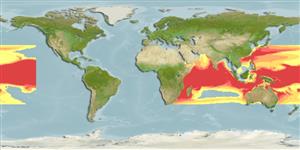>
Stomiiformes (Lightfishes and dragonfishes) >
Stomiidae (Barbeled dragonfishes) > Melanostomiinae
Etymology: Eustomias: Greek, eu = good + Greek, stoma = mouth (Ref. 45335).
Environment: milieu / climate zone / depth range / distribution range
Ecologie
marien bathypelagisch; diepte 0 - 1050 m (Ref. 11333). Deep-water; 36°N - 35°S, 18°E - 137°W
Southeast Atlantic: south and west of Cape of Good Hope, South Africa. Indo-Pacific: East Africa to the Society and Marquesan islands, north to southern Japan, south to Western Australia.
Grootte / Gewicht / Leeftijd
Maturity: Lm ? range ? - ? cm
Max length : 16.0 cm TL mannelijk / geslacht onbekend; (Ref. 3984); 15.5 cm SL (female)
Dorsale stekels (totaal) : 0; Dorsale zachte stralen (totaal) : 22 - 26; Anale stekels: 0; Anale zachte stralen: 32 - 37. A single, very small terminal bulb 0.3-0.6% SL. Barbel short 20-35% SL in specimens over 8 cm and some smaller ones, shorter in some developing specimens up to about 8 cm. Three pairs of short filaments; each filament of 1 pair with a prominent, elongate distal bulblet that may be larger than the terminal bulb; a pair slender , with closely spaced very small bulblets; a pair simple, with few or no occlusions, and usually the longest. Axis of stem moderately pigmented, becoming darker before bulb and very dark over 1 side of bulb, where pigment forks and extends along axis of the pair of filaments with large bulblets. External chevron-shaped or roundish striated areas unpigmented. Dorsal paired spots between occiput and dorsal-fin origin 9 or 10 (rarely 7 or 8) (Ref. 11333).
Levenscyclus en paargedrag
Maturiteit | Voortplanting | Paaien | Eieren | Fecunditeit | Larven
Gibbs, R.H. Jr., 1986. Melanostomiidae. p. 236-243. In M.M. Smith and P.C. Heemstra (eds.) Smiths' sea fishes. Springer-Verlag, Berlin. (Ref. 3984)
Status op de Rode Lijst van het IUCN (Ref. 130435: Version 2024-1)
Gevaar voor de mens
Harmless
Gebruik door de mens
Visserij: van geen belang
Tools
Speciale rapporten
Download XML
Internetbronnen
Estimates based on models
Preferred temperature (Ref.
123201): 9.2 - 21.3, mean 14.1 °C (based on 367 cells).
Fylogenetische diversiteitsindex (Ref.
82804): PD
50 = 0.5000 [Uniqueness, from 0.5 = low to 2.0 = high].
Bayesian length-weight: a=0.00302 (0.00116 - 0.00786), b=3.12 (2.89 - 3.35), in cm total length, based on LWR estimates for this (Sub)family-body shape (Ref.
93245).
Trofisch niveau (Ref.
69278): 4.2 ±0.8 se; based on size and trophs of closest relatives
Weerstandsvermogen (Ref.
120179): Gemiddeld, minimale populatieverdubbelingstijd 1,4-4,4 jaar (Assuming tmax>3).
Fishing Vulnerability (Ref.
59153): Low vulnerability (10 of 100).
